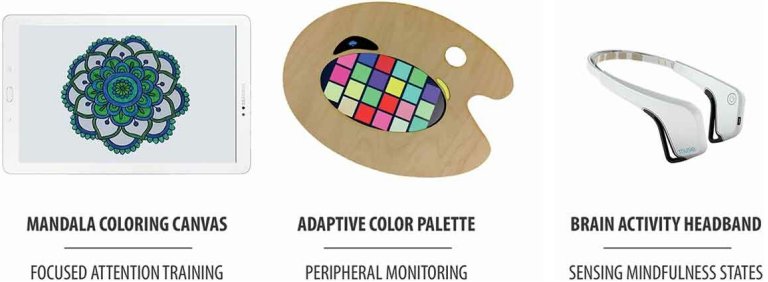
07/03/2022
Newsroom in Diario da Sade

A special electroencephalogram (EEG) device records brain signals, while a monitor, in the form of a plate, produces new colors based on EEG data.
[Imagem: Claudia Daudn Roquet]
Meditation with technology support
Computer technology has consistently been associated with decreased levels of attention and focus, as people quickly switch from one task to another without thinking deeply about either.
But a team from the UK believes it can be reversed.
Combining the traditional art of mandala coloring with sophisticated computational tools and brain discovery techniques could lead to new ways to help people achieve mindfulness.
With so many studies demonstrating the benefits of meditation, there has been a growing interest in developing techniques that help people develop techniques like mindfulness without having to stray from Western society’s way of life.
mandala coloring
Mandala coloring – the geometric formations of shapes that have its origins in the Buddhist tradition – is growing in popularity as a way for people to attempt to achieve a state of mindfulness, a way of being in the moment, and one that has been linked to helping people improve your mental health and well-being.
To aid in this process, and to confirm its effectiveness, the researchers developed a model system that monitors people’s brain signals as they color the mandala and produces real-time feedback on an assistive screen to represent levels of alertness.
Thus, the colors on the additional screen warn the person when his or her mind begins to exit the waking state.

Equipment used in Technology Assisted Meditation.
[Imagem: Claudia Daudn Roquet et al. – 10.1080/07370024.2021.1968864]
Technology in favor of focus
The prototype, called “Anima,” includes a tablet that users can color in mandalas, a wearable EEG sensor that reads users’ brain signals, and a second screen in the shape of a plate placed on the side.
Researchers believe that systems like this could be developed to help learn and train techniques for focusing attention, and help people deal with stress, depression, emotional problems, and other health disorders.
“The results of the study suggest two important and unacknowledged roles of mandalas: capturing and meditating on emotional memories. Technology can support these two roles in such a way that paper mandalas are less able to do so.
“Participants stated that they would much prefer working with completed mandalas in the thinking stage, and that they would look to recolor them, often with more positive colours, after thinking and changing their mental state. The techniques would be able to do this,” said Professor Corina Sass from Lancaster University (UK):
condition: Exploring Anima: A brain-computer interface for peripheral visualization of waking states while coloring mandalas
Authors: Claudia Dowden Rocket, Corina Sass, Dominic Potts
Publication: Human-computer interaction
doi: 10.1080/07370024.2021.1968864

“Friendly zombie guru. Avid pop culture scholar. Freelance travel geek. Wannabe troublemaker. Coffee specialist.”







